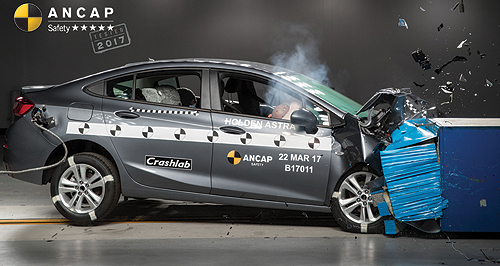News - General News - SafetyTime running out for car-makers dodging AEBBrakes on: Holden’s Astra sedan has been awarded a five-star safety rating, despite not having autonomous emergency braking on any variant. Autonomous braking set to become key for five-star ANCAP from next year25 May 2017 MOTOR manufacturers who serve up vehicles without autonomous emergency braking (AEB) are on borrowed time if they want to score a five-star safety rating from the independent Australasian New Car Assessment Program (ANCAP). Announcing five-star ratings for the new Subaru XV crossover and Holden Astra sedan, ANCAP chief executive officer James Goodwin warned that from January 1 next year car-makers will need to fit AEB as standard equipment if they want to get the top rating. “It is disappointing autonomous emergency braking is not available across the board on two new models, and we continue to encourage consumers to ask for, and brands to offer, this potentially life-saving technology,” he said. “As our requirements become more stringent next year, it will not be possible for new models to achieve a five-star ANCAP safety rating without an effective AEB system fitted as standard.” The new 2018 ANCAP test protocols will bring Australia into line with Euro NCAP which already demands safety assist systems such as AEB and lane support systems (LSS). The latter includes what some manufacturers dub lane-keeping assist and lane departure warning. ANCAP is also set to tighten up some child protection requirements, although child seat harness rules will still be slightly different to those in Europe because of unique Australian design rules. While the new Subaru XV small SUV has AEB and LSS on upper variants as options or standard equipment, its base variant has neither. AEB is not available on any Holden Astra sedan variant, while LSS is an option. The South Korean-built Astra sedan is known elsewhere as the Chevrolet Cruze, but was renamed Astra for Australia to bring it in line with the Astra hatch imported from Opel in Europe. While the Astra sedan and hatch are both built on General Motors’ Delta II platform, ANCAP says they are sufficiently different in structure, manufacturing source and specification to warrant separate crash tests. The Subaru XV, on the other hand, was given its five-star rating based on the crash performance of its small-car twin, the Impreza, which shares the same engineering makeup and factory. The Impreza was given a five-star rating by ANCAP when it was launched in Australia last November. It scored a commendable 35.8 points out of a possible 37 for adult occupant protection, only losing 1.2 points for “acceptable” lower leg and driver chest protection in the frontal offset crash test. All these scores were carried over for the Subaru XV which goes on sale in Australia next month. The Astra sedan – which was crash tested by ANCAP at Crashlab in Sydney and APV’s tech centre in Melbourne – scored 34.94 points out of 37. Like the XV/Impreza, the lower leg protection and driver chest protection were rated as acceptable, but so was the front-seat passenger’s chest protection. The Astra sedan’s pedestrian protection was rated only acceptable, unlike the Subaru XV’s protection that got the top “good” rating. Overall, the Astra sedan outperformed its hatch sibling that, while it still qualified for a five-star rating, earned 32.86 points for adult protection, again losing points for chest and lower leg impact. However, unlike the Cruze-based sedan, the hatch comes with AEB for city driving on three variants – R+, RS and RS-V.  Read more |
Click to shareGeneral News articlesResearch General News Motor industry news |




















Facebook Twitter Instagram